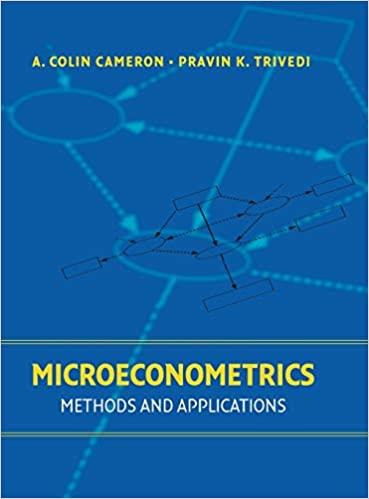The literature on intergenerational mobility uses the following model (Solon, 1992; Zimmerman, 1992): [ begin{equation*} Y_{i}^{text {son
Question:
The literature on intergenerational mobility uses the following model (Solon, 1992; Zimmerman, 1992):
\[ \begin{equation*} Y_{i}^{\text {son }}=\alpha+\beta Y_{i}^{\text {father }}+\varepsilon_{i}^{\text {son }} \tag{26.26} \end{equation*} \]
with \(\varepsilon_{i} \sim \operatorname{iid} \mathcal{N}\left[0, \sigma^{2}\right]\). Here \(Y\) is a measure of permanent status (such as permanent income) and \(\beta\) measures the degree of regression toward the mean in economic status. Suppose that permanent status is not observed. Instead, current status \(Y_{i t}\) is observed with \(Y_{i t}=Y_{i}+\gamma X_{i t}+w_{i t}\), so that \(Y_{i t}\) is composed of an individual fixed effect \(Y_{i}\), referred to as the permanent status, a systematic factors \(X_{i t}\), and a transitory error component \(w_{i t}\). Let \(\widehat{\gamma}\) denote the fitted least-squares coefficient, and let
\[ Y_{i t}-\widehat{\gamma} X_{i t}=Y_{i}+(\gamma-\widehat{\gamma}) X_{i t}+w_{i t}=Y_{i}+v_{i t} \]
(a) Let \(\bar{Y}_{i}^{\text {father }}=T^{-1} \sum_{t=1}^{T} Y_{i t}^{\text {father }}\) denote an average of father's status used as the independent variable, a proxy, for the unobserved permanent status in (26.26). Let \(\widehat{\beta}_{\text {avg }}\) denote the corresponding regression coefficient. Show that plim \(\widehat{\beta}_{\text {avg }}=\beta P_{Y}\), where \(P_{Y}=\sigma_{Y}^{2} /\left(\sigma_{Y}^{2}+T^{-1} \sigma_{\varepsilon}^{2}\right)\).
(b) Assume that the transitory component of father's earnings follows an autoregressive scheme, \(v_{i t}^{\text {father }}=ho v_{i t}^{\text {father }}+\xi_{i t}\), where \(\xi_{i} \sim \mathcal{N}\left[0, \sigma_{\xi}^{2}\right], i=1, \ldots, T\). Show that now plim \(\widehat{\beta}_{\text {avg }}=\beta P_{Y}^{*}\), where \(P_{Y}^{*}=\sigma_{Y}^{2} /\left(\sigma_{Y}^{2}+T^{-1} V\right)\) and \(V=\) \(\sigma_{\xi}^{2}\left[T\left(1-ho^{2}\right)\right]^{-1}\left[\left(1+2 ho\left\{T-\left(1-ho^{T}\right) /(1-ho)\right\} / T(1-ho)\right]\right.\).
Step by Step Answer:

Microeconometrics Methods And Applications
ISBN: 9780521848053
1st Edition
Authors: A.Colin Cameron, Pravin K. Trivedi





